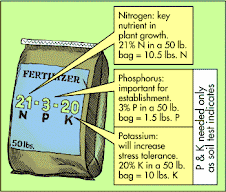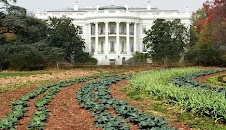 Summer sunshine is closer than you think! Plan and prepare now for a bountiful harvest of healthy, home grown vegetables. Soil preparation, plant selection, fertilizer, water and sunshine will provide an abundance of vegetables throughout the spring and summer. Stick with your garden and eat well!
Summer sunshine is closer than you think! Plan and prepare now for a bountiful harvest of healthy, home grown vegetables. Soil preparation, plant selection, fertilizer, water and sunshine will provide an abundance of vegetables throughout the spring and summer. Stick with your garden and eat well!Soil Preparation: Select a sunny, well drained site. At least eight hours of full sun is necessary. Place your garden where it is very handy for you to get to on a daily basis. If your soil is heavy clay, consider a raised bed. Build a frame of 2” X 6” X 8” planks. Size is determined for ease of reaching in. Treated lumber will last longer. Fill with top soil.
 If not using raised beds, examine your soil. If it is loose and mealy in your hand and a rich dark color, consider yourself lucky. Such soil will reward you. Good soil has some sand; some rotted organic material and clay. Less than 20% sand or organic material means you should amend your soil with organic material like compost, sawdust, leaf mold or other organic material. This will aerate your soil, making it easy for roots to grow downward
If not using raised beds, examine your soil. If it is loose and mealy in your hand and a rich dark color, consider yourself lucky. Such soil will reward you. Good soil has some sand; some rotted organic material and clay. Less than 20% sand or organic material means you should amend your soil with organic material like compost, sawdust, leaf mold or other organic material. This will aerate your soil, making it easy for roots to grow downwardCultivate your soil loosely with shovel and hoe or a power tiller. Leave clumps no smaller than 2 to 3 inches. Cultivating soil too finely will cause it to compact more easily. Plan how you will water your garden. Place a sprinkler in the middle and plan to run a hose to it. Your garden will need at least a weekly deep watering in the heat of summer. A deep watering means about one hour of full sprinkling that soaks in freely.
 Sketch your garden plot on paper and plan your plantings. Put the taller plants together, either in the middle or to one side. Plan taller plants where they shade other plants the least. Plant cool weather plants along the edges where they can be easily reached and when harvested can be easily reseeded with hot weather plants. Plan your plot with an eye for beauty as well as convenience. Add border of low growing flowers or a row of zinnias for cutting. Place a teepee trellis’s for beans in the middle for shading cool weather plants and to height and visual interest to the middle. Or put a birdhouse in the middle after your seeds sprout. Birds will eat bugs.
Sketch your garden plot on paper and plan your plantings. Put the taller plants together, either in the middle or to one side. Plan taller plants where they shade other plants the least. Plant cool weather plants along the edges where they can be easily reached and when harvested can be easily reseeded with hot weather plants. Plan your plot with an eye for beauty as well as convenience. Add border of low growing flowers or a row of zinnias for cutting. Place a teepee trellis’s for beans in the middle for shading cool weather plants and to height and visual interest to the middle. Or put a birdhouse in the middle after your seeds sprout. Birds will eat bugs. Plant seeds and plants in rows or squares. Label them with popsicle sticks or plastic spoons. Planting seeds is much less expensive. However purchased plants will give you a head start. Vining plants like cucumber, squash and melons require room to spread out. Plant them in a small hill for each plant. Tomatoes plants of all varieties can be planted two to four inches lower than the top of their root ball to give deeper roots. Tomatoes have unusual stems that will produce roots when transplanted more deeply.
 Peppers, radishes, carrots, tomatoes, sweet corn, green beans and peas are good plants for the beginning gardener. These grow readily from seed. Plant according to seed instructions, but most seeds can be started outdoors in Eastern Kentucky in mid April. If you live in a valley, you will be affected by frost a week or so later. Lettuces, broccoli and other cool weather plants can be started in late March to early April. Be prepared to cover them if frost is warned.
Peppers, radishes, carrots, tomatoes, sweet corn, green beans and peas are good plants for the beginning gardener. These grow readily from seed. Plant according to seed instructions, but most seeds can be started outdoors in Eastern Kentucky in mid April. If you live in a valley, you will be affected by frost a week or so later. Lettuces, broccoli and other cool weather plants can be started in late March to early April. Be prepared to cover them if frost is warned. Fertilize when seedlings are 2 inches high. Dilute fertilizer by one half until plants are 5 inches tall. Use an all purpose vegetable garden fertilizer at package recommended intervals. Dry fertilizers can be broadcast into the soil before planting. Organic fertilizer such as fish emulsion can also be used. Fish emulsion must be diluted so follow package instructions carefully. It has a strong odor that will fade in a day or two.
 Mulch seedlings with straw, grass clippings or shredded commercial mulch. Underlay with a layer of newspapers. Don’t use plastic or landscape mesh. This will control weeds and maintain moisture more readily in the soil. Prepare to weed, although much less if you mulch. If you allow weeds to develop the weeds will compete with your plants for moisture and sun. Trust me the weeds will win unless you keep after them early and regularly.
Mulch seedlings with straw, grass clippings or shredded commercial mulch. Underlay with a layer of newspapers. Don’t use plastic or landscape mesh. This will control weeds and maintain moisture more readily in the soil. Prepare to weed, although much less if you mulch. If you allow weeds to develop the weeds will compete with your plants for moisture and sun. Trust me the weeds will win unless you keep after them early and regularly.An 8 X 8 plot can yield a lot of vegetables. Double that and you will be kept quite busy. More than that and you will have lots to preserve or give away.
Raising a vegetable garden is a rewarding experience. Involve your children. Ripe tomatoes warm from the sun have no equal. Enjoy the fruits of your labors through the summer and share with your friends. Freeze and can in late summer and truly recoup a large investment. Stand in amazement at the nourishment a few feet of well tended earth will yield. A vegetable garden gives an earthy, touchable meaning to the notion of God’s bounty. Being fed from your own backyard will give a renewed appreciation of the value of the earth, rain and sun.
Community Gardens: Don’t have space or know how for a garden? Community gardens are now being cultivated near the Recycling Center. These are available to everyone. Contact David Dummer at 780-0076 for more information.















